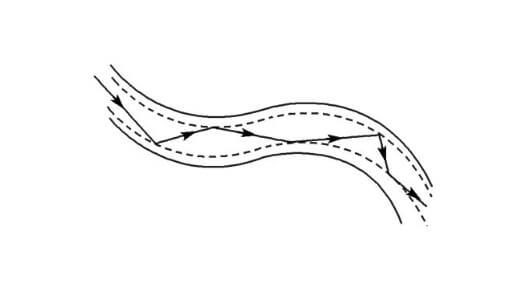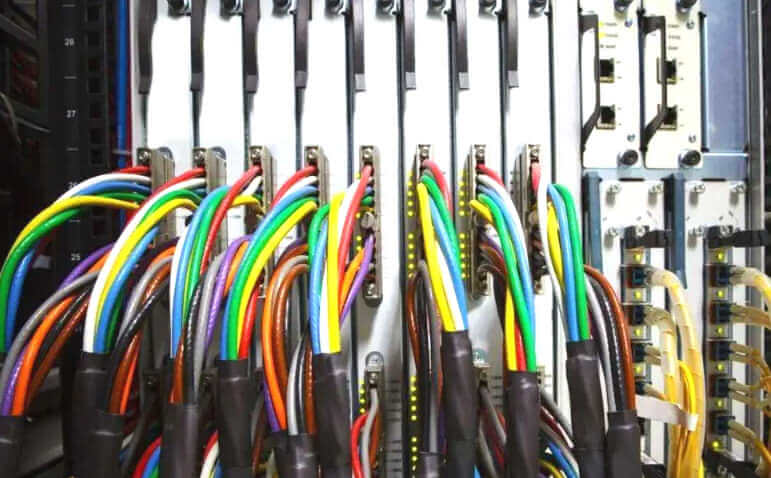Cables with copper conductors transmit electrical signals, while optical fibers transmit optical signals. There are two types of general network access, cable access and fiber optic Internet access.
We know that light travels faster than electricity in a vacuum.. So, Is fiber optic Internet access really faster than cable access??
Cables are faster than optical fibers in the ideal case
The path that light travels in an optical fiber is a zigzag. This is because light travels in optical fibers constant total reflection. Therefore, the light signal travels a greater distance. Ideally, the copper cable should run in a straight line

Light travels to 299.792.458 meters per second in a vacuum. Nevertheless, in the rest of the middle, the speed of light is greatly reduced.
In a quartz glass optical fiber, The signal travels at a speed of 200.000.000 meters per second. on the copper wire, The electrical signal travels at a speed of approximately 230.000.000 meters per second.
Optical fibers are faster than cables in practical applications
Optical signals have a very high frequency and the fiber bandwidth is very wide.. Thus, fiber optics can accommodate more signals that are transmitted simultaneously.
Besides, Signal attenuation in optical fibers is much lower than that of electrical signals in copper cables. Optical signals are more resistant to interference than electrical signals.
According to him the Shannon-Hartley theorem, Transmission speed is directly influenced by signal-to-noise ratio. Optical fibers have low signal loss. That is why the transmission speed of optical fibers is faster than that of cables..
If losses due to repeaters and electromagnetic interference are included, copper cable performance is even worse.
For example, A most commonly used twisted pair cable can only travel up to 100 m. Longer distances require a repeater to continue the signal. And can only be used a limited number of times. Each repeater also consumes time.
So, light transmission loss in optical fiber is much less than the loss of a point in a cable. It usually travels distances of several thousand meters or more.
In simple terms, if the transmitted signal is compared to the traffic flow, fiber optic line It is equivalent to a relatively slow but flat road of 10 lanes. And the cable is the equivalent of a faster but bumpy one-lane highway.
In practice, Fiber optic cable has greater transmission capacity than copper cable. It has a long relay section distance, a small size, light weight and has no electromagnetic interference.
As a result, has become the backbone of cable transmission lines for long-distance trunk lines, intraurban relays, las offshore and transoceanic underwater communications, as well as local area networks and private networks.

What are the differences between optical fibers and cables?
Material and structure
A fiber optic cable is made up of two or more fiberglass or plastic cores.. electrical cables, instead, have a metal as a conductor, mainly aluminum or copper.
Inside the cable there are mainly copper wires. The core diameters are 0,32 mm, 0,4 mm, 0,5 mm, etc. As a rule, the larger the diameter, the greater the communication capacity. There are also subdivisions according to the number of cores, 5 pares, 10 pares, 20 pares, 50 pares, 100 pares, 200 pares, etc.
Instead, Fiber optic cables only have the number of cores, What are they 4 pares, 6 pares, 8 pares, 12 pares, 24 pares, etc.
Signal and transmission speed
Cables transmit electrical signals, while optical fibers transmit optical signals. Fiber optic optical transmission is multiplexed and, so, The optical signal is transmitted much faster than the electrical signal of a normal cable.
The world's fastest speed for commercial fiber optic network connections with a single laser transmitter has reached 100 GB per second. At the same time, Fiber optic transmission supports connection distances of up to two kilometers or more. So fiber becomes the best option to form large-scale networks.
Transmission principle
Cables usually transmit energy in the form of an electric current under the action of a voltage.. Next, It is processed through a transformer to convert it into electrical energy suitable for use..
optical fibers, instead, first convert an electrical signal into an optical signal. Next, Light pulses are transmitted to the optical fiber using a light-emitting diode or laser through a transmitter at one end. The receiving device at the other end of the fiber uses a photosensitive element to detect the pulses. Finally, the light signal is converted back into an electrical signal.

Range of applications
Compared to copper core cables, Fiber optic cables have the advantages of good resistance to electromagnetic interference, high confidentiality, high speed and large transmission capacity. So, It is also more expensive due to its cost.
Before, fiber optic cables were less used in personal or domestic situations. They were mainly used for large-scale data transmission.. The cables, instead, They were mainly used for power transmission and low-end transmission of data and information., with a wider range of applications.
Nevertheless, with the progress of times, Telecommunications operators and cable operators have gradually laid fiber optic cables of 4 pares a 12 core pairs for residential and commercial areas.
Begins to develop in the field of intra-urban subscriber loop cabling networks, providing transmission lines for fiber to the home (FTTH) and integrated services of broad generation.
We hope this information can help you. ZMS CABLE we offer a wide range of reliable copper cables and fiber optic cables. If you have any questions, Contact us.
